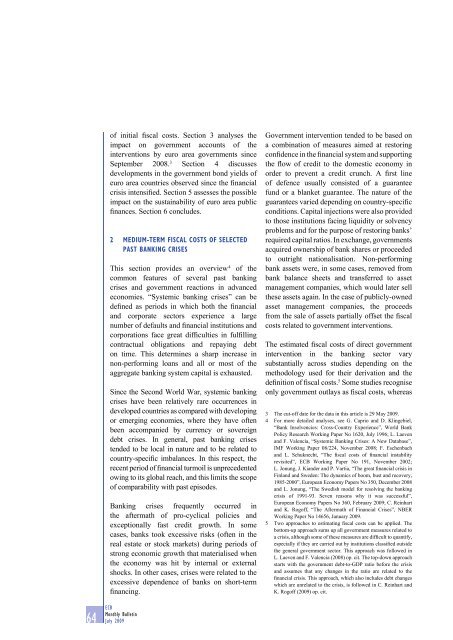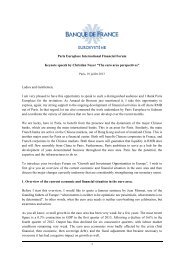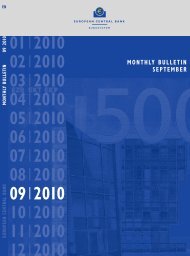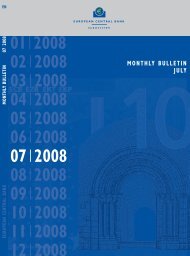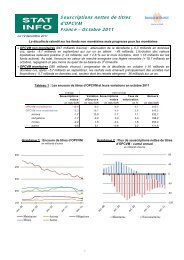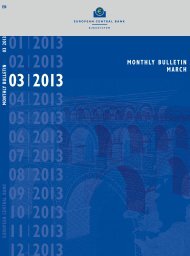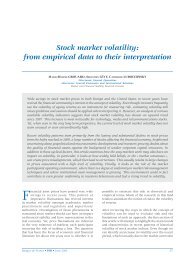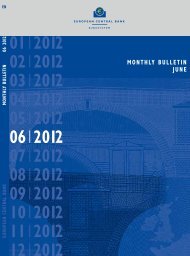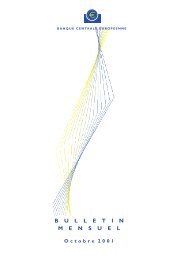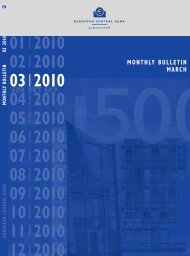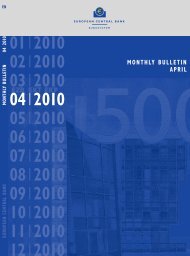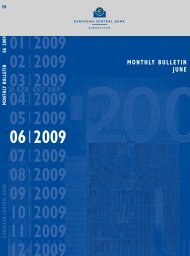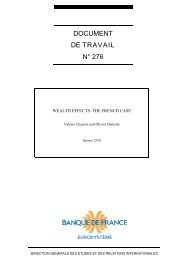Monthly Bulletin July 2009 - Banque de France
Monthly Bulletin July 2009 - Banque de France
Monthly Bulletin July 2009 - Banque de France
Create successful ePaper yourself
Turn your PDF publications into a flip-book with our unique Google optimized e-Paper software.
of initial fiscal costs. Section 3 analyses the<br />
impact on government accounts of the<br />
interventions by euro area governments since<br />
September 2008. 3 Section 4 discusses<br />
<strong>de</strong>velopments in the government bond yields of<br />
euro area countries observed since the financial<br />
crisis intensified. Section 5 assesses the possible<br />
impact on the sustainability of euro area public<br />
finances. Section 6 conclu<strong>de</strong>s.<br />
2 MEDIUM-TERM FISCAL COSTS OF SELECTED<br />
PAST BANKING CRISES<br />
This section provi<strong>de</strong>s an overview 4 of the<br />
common features of several past banking<br />
crises and government reactions in advanced<br />
economies. “Systemic banking crises” can be<br />
<strong>de</strong>fined as periods in which both the financial<br />
and corporate sectors experience a large<br />
number of <strong>de</strong>faults and financial institutions and<br />
corporations face great difficulties in fulfilling<br />
contractual obligations and repaying <strong>de</strong>bt<br />
on time. This <strong>de</strong>termines a sharp increase in<br />
non-performing loans and all or most of the<br />
aggregate banking system capital is exhausted.<br />
Since the Second World War, systemic banking<br />
crises have been relatively rare occurrences in<br />
<strong>de</strong>veloped countries as compared with <strong>de</strong>veloping<br />
or emerging economies, where they have often<br />
been accompanied by currency or sovereign<br />
<strong>de</strong>bt crises. In general, past banking crises<br />
ten<strong>de</strong>d to be local in nature and to be related to<br />
country-specific imbalances. In this respect, the<br />
recent period of financial turmoil is unprece<strong>de</strong>nted<br />
owing to its global reach, and this limits the scope<br />
of comparability with past episo<strong>de</strong>s.<br />
Banking crises frequently occurred in<br />
the aftermath of pro-cyclical policies and<br />
exceptionally fast credit growth. In some<br />
cases, banks took excessive risks (often in the<br />
real estate or stock markets) during periods of<br />
strong economic growth that materialised when<br />
the economy was hit by internal or external<br />
shocks. In other cases, crises were related to the<br />
excessive <strong>de</strong>pen<strong>de</strong>nce of banks on short-term<br />
financing.<br />
Government intervention ten<strong>de</strong>d to be based on<br />
a combination of measures aimed at restoring<br />
confi<strong>de</strong>nce in the financial system and supporting<br />
the flow of credit to the domestic economy in<br />
or<strong>de</strong>r to prevent a credit crunch. A first line<br />
of <strong>de</strong>fence usually consisted of a guarantee<br />
fund or a blanket guarantee. The nature of the<br />
guarantees varied <strong>de</strong>pending on country-specific<br />
conditions. Capital injections were also provi<strong>de</strong>d<br />
to those institutions facing liquidity or solvency<br />
problems and for the purpose of restoring banks’<br />
required capital ratios. In exchange, governments<br />
acquired ownership of bank shares or procee<strong>de</strong>d<br />
to outright nationalisation. Non-performing<br />
bank assets were, in some cases, removed from<br />
bank balance sheets and transferred to asset<br />
management companies, which would later sell<br />
these assets again. In the case of publicly-owned<br />
asset management companies, the proceeds<br />
from the sale of assets partially offset the fiscal<br />
costs related to government interventions.<br />
The estimated fiscal costs of direct government<br />
intervention in the banking sector vary<br />
substantially across studies <strong>de</strong>pending on the<br />
methodology used for their <strong>de</strong>rivation and the<br />
<strong>de</strong>finition of fiscal costs. 5 Some studies recognise<br />
only government outlays as fiscal costs, whereas<br />
3 The cut-off date for the data in this article is 29 May <strong>2009</strong>.<br />
4 For more <strong>de</strong>tailed analyses, see G. Caprio and D. Klingebiel,<br />
“Bank Insolvencies: Cross-Country Experience”, World Bank<br />
Policy Research Working Paper No 1620, <strong>July</strong> 1996; L. Laeven<br />
and F. Valencia, “Systemic Banking Crises: A New Database”,<br />
IMF Working Paper 08/224, November 2008; F. Eschenbach<br />
and L. Schuknecht, “The fiscal costs of financial instability<br />
revisited”, ECB Working Paper No 191, November 2002;<br />
L. Jonung, J. Kian<strong>de</strong>r and P. Vartia, “The great financial crisis in<br />
Finland and Swe<strong>de</strong>n: The dynamics of boom, bust and recovery,<br />
1985-2000”, European Economy Papers No 350, December 2008<br />
and L. Jonung, “The Swedish mo<strong>de</strong>l for resolving the banking<br />
crisis of 1991-93. Seven reasons why it was successful”,<br />
European Economy Papers No 360, February <strong>2009</strong>; C. Reinhart<br />
and K. Rogoff, “The Aftermath of Financial Crises”, NBER<br />
Working Paper No 14656, January <strong>2009</strong>.<br />
5 Two approaches to estimating fiscal costs can be applied. The<br />
bottom-up approach sums up all government measures related to<br />
a crisis, although some of these measures are difficult to quantify,<br />
especially if they are carried out by institutions classified outsi<strong>de</strong><br />
the general government sector. This approach was followed in<br />
L. Laeven and F. Valencia (2008) op. cit. The top-down approach<br />
starts with the government <strong>de</strong>bt-to-GDP ratio before the crisis<br />
and assumes that any changes in the ratio are related to the<br />
financial crisis. This approach, which also inclu<strong>de</strong>s <strong>de</strong>bt changes<br />
which are unrelated to the crisis, is followed in C. Reinhart and<br />
K. Rogoff (<strong>2009</strong>) op. cit.<br />
64 ECB<br />
<strong>Monthly</strong> <strong>Bulletin</strong><br />
<strong>July</strong> <strong>2009</strong>


